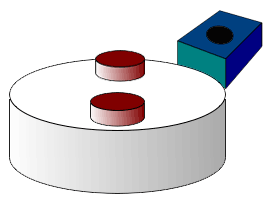Hall effect sensor: Difference between revisions
No edit summary |
|||
| Line 15: | Line 15: | ||
==Hall probe== |
==Hall probe== |
||
Hehehehe... probe. |
|||
A hall probe contains an [[indium]] compound crystal such as [[Indium_antimonide#Device_applications|indium antimonide]], mounted on an [[aluminum]] backing plate, and encapsulated in the probe head. The plane of the crystal is perpendicular to the probe handle. Connecting leads from the crystal are brought down through the handle to the circuit box. |
A hall probe contains an [[indium]] compound crystal such as [[Indium_antimonide#Device_applications|indium antimonide]], mounted on an [[aluminum]] backing plate, and encapsulated in the probe head. The plane of the crystal is perpendicular to the probe handle. Connecting leads from the crystal are brought down through the handle to the circuit box. |
||
Revision as of 19:31, 16 November 2010


A Hall effect sensor is a transducer that varies its output voltage in response to changes in magnetic field. Hall sensors are used for proximity switching, positioning, speed detection, and current sensing applications.
In its simplest form, the sensor operates as an analogue transducer, directly returning a voltage. With a known magnetic field, its distance from the Hall plate can be determined. Using groups of sensors, the relative position of the magnet can be deduced.
Electricity carried through a conductor will produce a magnetic field that varies with current, and a Hall sensor can be used to measure the current without interrupting the circuit. Typically, the sensor is integrated with a wound core or permanent magnet that surrounds the conductor to be measured.
Frequently, a Hall sensor is combined with circuitry that allows the device to act in a digital (on/off) mode, and may be called a switch in this configuration. Commonly seen in industrial applications such as the pictured pneumatic cylinder, they are also used in consumer equipment; for example some computer printers use them to detect missing paper and open covers. When high reliability is required, they are used in keyboards.
Hall sensors are commonly used to time the speed of wheels and shafts, such as for internal combustion engine ignition timing, tachometers and anti-lock braking systems. They are used in brushless DC electric motors to detect the position of the permanent magnet. In the pictured wheel carrying two equally spaced magnets, the voltage from the sensor will peak twice for each revolution. This arrangement is commonly used to regulate the speed of disc drives.
Hall probe
Hehehehe... probe.
A hall probe contains an indium compound crystal such as indium antimonide, mounted on an aluminum backing plate, and encapsulated in the probe head. The plane of the crystal is perpendicular to the probe handle. Connecting leads from the crystal are brought down through the handle to the circuit box.
When the Hall Probe is held so that the magnetic field lines are passing at right angles through the sensor of the probe, the meter gives a reading of the value of magnetic flux density (B). A current is passed through the crystal which, when placed in a magnetic field has a “Hall Effect” voltage developed across it. The Hall Effect is seen when a conductor is passed through a uniform magnetic field. The natural electron drift of the charge carriers causes the magnetic field to apply a Lorentz force (the force exerted on a charged particle in an electromagnetic field) to these charge carriers. The result is what is seen as a charge separation, with a build up of either positive or negative charges on the bottom or on the top of the plate. The crystal measures 5 mm square. The probe handle, being made of a non-ferrous material, has no disturbing effect on the field.
A Hall Probe is enough to measure the Earth's magnetic field. It must be held so that the Earth's field lines are passing directly through it. It is then rotated quickly so the field lines pass through the sensor in the opposite direction. The change in the flux density reading is double the Earth's magnetic flux density. A hall probe must first be calibrated against a known value of magnetic field strength. For a solenoid the hall probe is placed in the center.
Hall Effect Sensor Interface
Hall effect sensor may require analog circuitry to be interfaced to microprocessors. These interfaces may include input diagnostics, fault protection for transient conditions and short/open circuit detection. It may also provide and monitor the current to the hall effect sensor itself. There are precision IC products available to handle these features. For example the Hall Effect Interface IC from Maxim Integrated Products is MAX9921.
Further reading
- Ed Ramsden (2006). Hall-effect sensors: theory and applications (2, ilustrated ed.). Elsevier. ISBN 0750679344.
- R. S. Popović (2004). Hall effect devices (2, ilustrated ed.). CRC Press. ISBN 0750308559.
- Classical Hall effect in scanning gate experiments: A. Baumgartner et al., Phys. Rev. B 74, 165426 (2006), doi:10.1103/PhysRevB.74.165426

